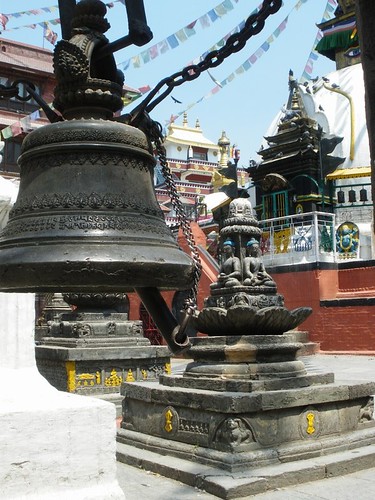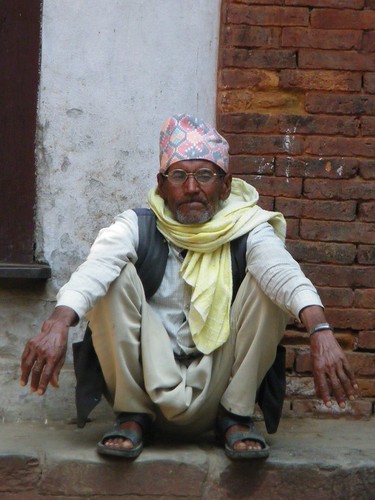For this reason I have decided to open a new section named 'Gezellig World'. Gezellig is my favourite Dutch word. In a brave attempt to translate this term I'd say that it describes a small place or group of people wherein one feels confortable, happy, welcomed. Therefore within this category I'll include different projects and initiatives characterised by a firm solidary nature which -in my opinion- can serve as an inspiration.
To kick off I'll tell you a little bit about Suvadra. It was during my New Year's Day visit to Bhaktapur that I came across a group of disabled children uniformed in grey T-shirts. Apart from the homogeneus clothes, there was something that called my attention in a special way: every single one of the sixteen little boys and girls presented an immesurable smile in their face. I challenged myself to discover the source of their overwhelimg happiness. That's how I met Joyce and Krishna. They are the people in charge of this Dutch-Nepali NGO founded in 2006. This tiny and exquisitely managed organisation takes care of physically -and sometimes mentally too- disabled children from all over Nepal.
Their main project consists in running an adapted home where children can live, learn, play and be treated in a loving environment.
 Recalling Joyce's words, one of the main principles of the Nepali society is to watch for themselves before anyone else. While this is understandable in a country plunged in poverty, it consignes these unlucky infants to oblivion. As in the European medievo, some of these unfortunate kids are considered a divine punishment by their families. Consequenly the inocent boys and girls are in some cases kept in the dark rooms of the house - where the neighbours' prejudicing eyes do not reach.
Recalling Joyce's words, one of the main principles of the Nepali society is to watch for themselves before anyone else. While this is understandable in a country plunged in poverty, it consignes these unlucky infants to oblivion. As in the European medievo, some of these unfortunate kids are considered a divine punishment by their families. Consequenly the inocent boys and girls are in some cases kept in the dark rooms of the house - where the neighbours' prejudicing eyes do not reach.Then, how can you explain these children's exulting joy? Well, by looking at passionate work of their caretakers. The privately funded organisation runs on Nepali workers and foreign volunteers. This is the case of -among others- Helen and Peter. These two young dutchies ended up living in the communal house during a break from their studies or early careers. Whether it is only for a few weeks or half a year, these guys learn and put in practice improvised care skills. The positive response of the children shows that mostly love and attention suffice their major needs. Nevertheless Joyce explained that the organisation lacks some professional phisiotherapist to treat the children and to train the Nepali team.
In conclusion, here there is a good alternative for anyone interested in spending some weeks or months in a gorgeus Newari town surrounded by the Himalayan mountains, living in a friendly house, spending very little money and getting much more than anyone could ever give. More info at http://www.suvadra.com/
PS: If you think that disabled children might be too much for you, you can also check another little project run by a couple of Dutch ladies that I met in Pokhara. Here their website: http://stichting-namaste-nepal.nl/
Cuando comence este blog me propuse descubriros algunas de las maravillas que pueblan nuestro planeta. Hasta ahora os he hablado de paisajes, palacios, comidas y actividades entre otras cosas; sin embargo, todavia no he hecho mencion explicita de la gente maravillosa que trabaja para hacer de este mundo un sitio mejor. Por ello, y para homenajear a estos heroes anonimos he decidido inaugurar una nueva seccion llamada 'Gezellig World'. Esta combinacion de terminos holandes e ingles engloba aquellas iniciativas que me encuentro en mi camino y que me llaman especialmente la atencion por su caracter solidario.
Para estrenar la seccion os hablare de Suvadra. En mi visita Bhaktapur me tope con una tribu de niños minusvalidos. Aparte de su uniforme gris, lo que me llamo especialmente la atencion fueron sus amplias sonrisas. ¿Como se explica tanta felicidad en un pais donde los niños con este tipo de afecciones son en muchas ocasiones considerados un castigo divino (y recluidos en sus casas)? Pues bien, gracias al duro trabajo de gente como Joyce y Krishna. Estos responsables comandan una pequeña ONG holendesa-nepali en la que trabajadores nepalis y voluntarios extranjeros colaboran para mantener un hogar adaptado a las necesidades de 16 niños y niñas con problemas fisicos (y a veces psiquicos). Este es el caso de Helen y Peter, dos jovenes holandeses que decidieron tomar un parentesis en sus carreras (academicas y laborales) para poner en practica improvisados cuidados. A juzgar por la respuesta de los niños la atencion y el cariño son suficientes en la mayoria de los casos; sin embargo, Joyce me comento que la organizacion necesita fisioterapeutas dispuestos a ayudar a formar al equipo nepali para llevar a cabo los tratamientos.
En conclusion, he aqui una buena alternativa para disfrutar de unas semanas o meses en uno de los pueblos mas bonitos con vistas a los Himalayas donde podreis ayudar y disfrutar de la compañia de estos niños tan majos gastando muy poco dinero y recibiendo mucho mas de lo que jamas podreis dar. Mas info: www.suvadra.com


